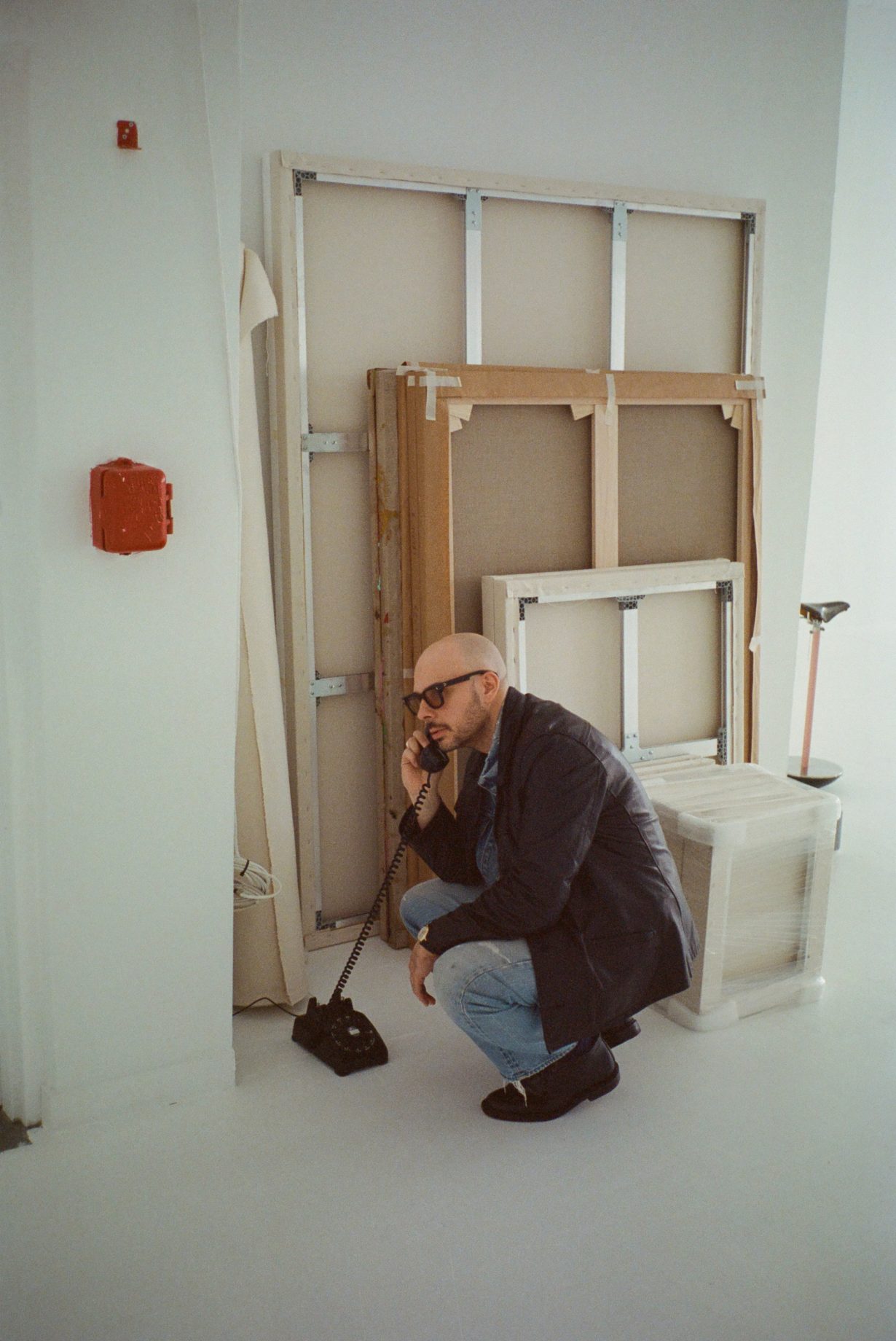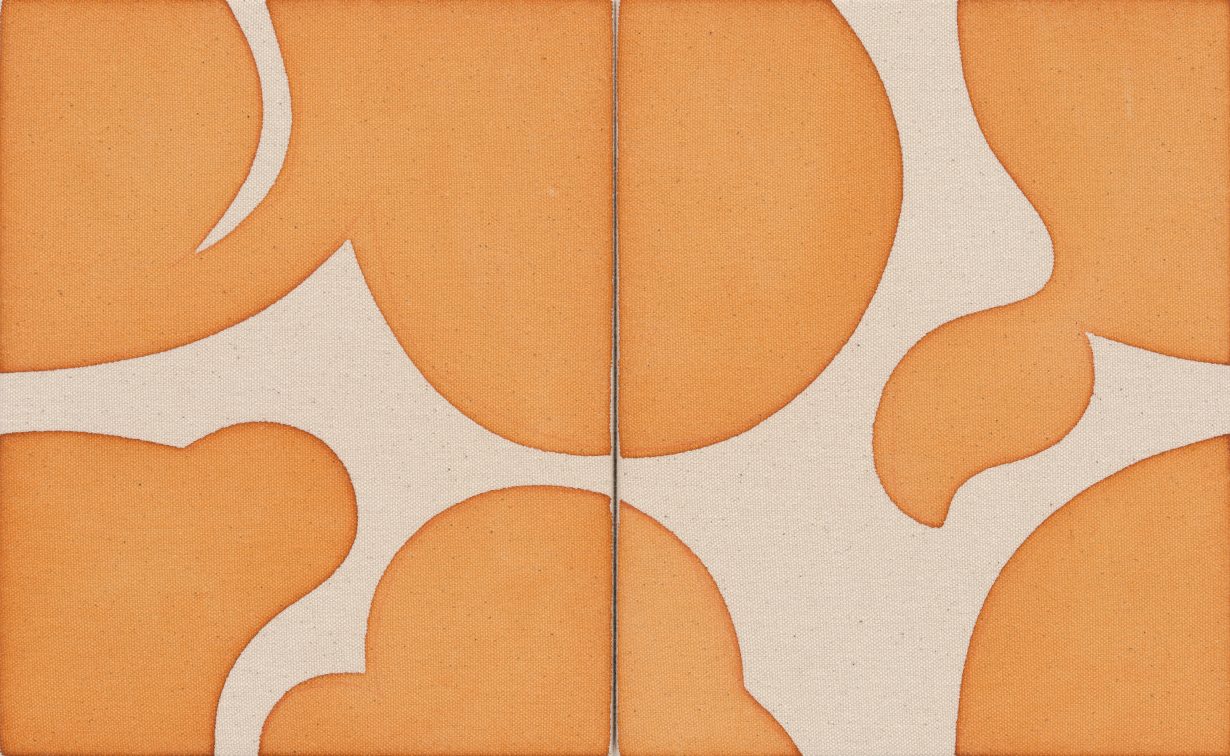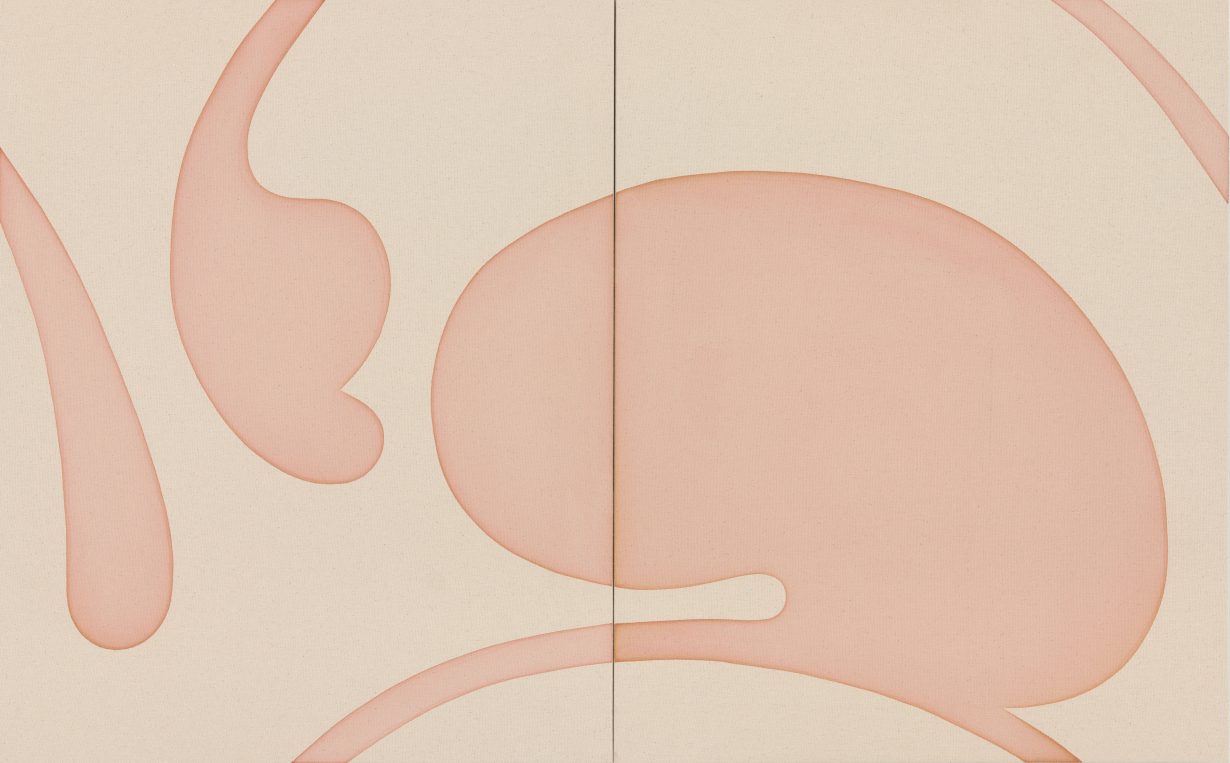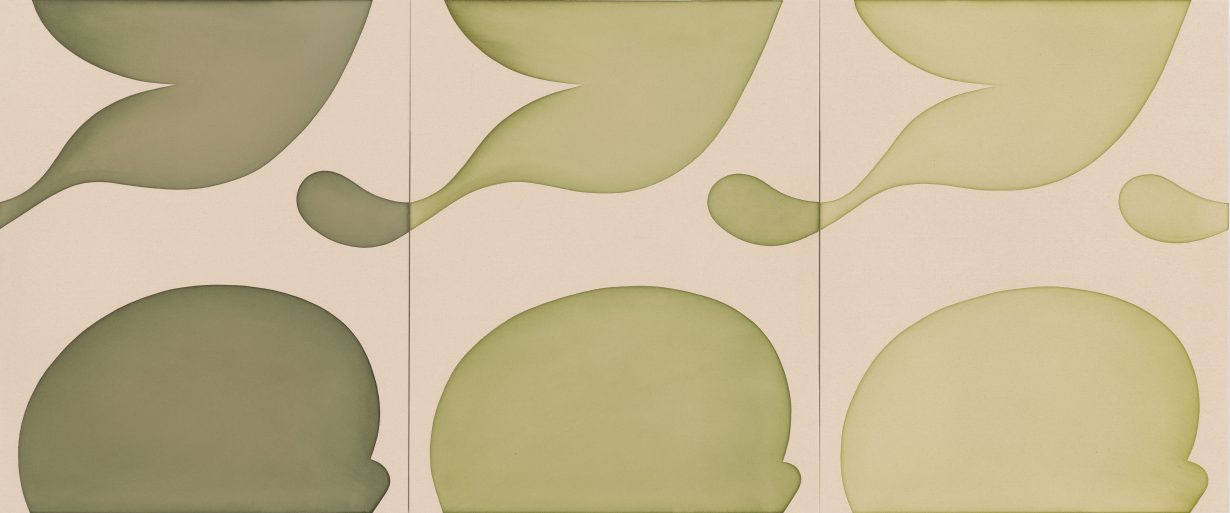On 20 June at Waddington Custot, London, Landon Metz and ArtReview Editor Fi Churchman were in conversation for the New York-based painter’s second exhibition at the gallery

In his exhibition (through 9 August), Landon Metz proposes a visual aesthetic for an alternative mode of being to the fast-paced hullabaloo of modern urban life. In abstract, languid paintings, Metz pursues a tranquility of form and colour, which viewers are encouraged to experience in a moment of stillness.
Metz cites as a key influence the American avant-garde composer John Cage, who suggested that in ‘listening’ to silence, we become far more perceptive to the ambient noises that surround us at any given moment. Metz translates Cage’s idea to space and canvas, the abstract shapes in his paintings appearing by turns enigmatic, like passing clouds, or suspenseful, like pockets of air trapped beneath a sealed-off surface.
Like Helen Frankenthaler, another of the artist’s influences, Metz achieves his abstract forms by the soak-stain method: pouring thinned paint onto unprimed, horizontal canvas. Works are hung floor-to-ceiling above one another, or beside one another; while others appear to fold around corners of the room.
The following conversation is a transcript from the opening event.

ArtReview Can you tell us about your process?
Landon Metz It starts with a raw canvas – it’s untreated, unprimed. I use an acrylic wash. So the medium is very low viscosity. It’s like probably 98% water. And there’s a little bit of pigment and a few other things that I mix in. After I mix the colours, I’ll start shape making, composition making, and that’s a really playful, fun part of the studio practice.
AR There’s a nice video of you in your studio making work. And I think what’s sort of striking about seeing the way you work with canvases laid on the floor is how much you’re actually moving as you’re making it – you’re kind of stretching all over the place.
LC Yeah. It’s kind of like a yoga thing. I work on the floor, so I also support my weight with my arms. I think it keeps me strong – which is necessary to be able to deal with it. But the process is very physical, especially the larger works; the smaller works I prefer to make on the table, obviously. But these larger pieces had to be produced on the floor.
AR You describe your works as ‘site-responsive’. What’s your interpretation of ‘site-responsive’ work as opposed to those that are labelled ‘site-specific’?
LM I think for me, ‘site-responsive’ is about acknowledging the inherent properties of the surrounding space. Any given room or environment has a pretence to it, right? When we walk into a gallery – and I’m not speaking about the architecture, but the place itself – it’s preconditioned. We know what it means to be in the space: the volume of our voice, how we are going to move, the kind of conversations that we have. There’s a story that we tell ourselves before we enter that environment. It is very different from, say, the stories that we tell ourselves about a café, or our home, or a church, or whatever. So, it’s sort of the predispositions, I suppose, of the environment that are part of it, and also the space itself: the architecture, the decisions that the architect made, and the way buildings are situated within streets. There are technical problems that have to be solved in architecture. So for me, ‘site-responsive’ means I’m acknowledging that sites have properties, without altering them. It’s about calling attention to something within the space, the place and the details of that environment, and also our expectations as to how we approach that space and how we cross that threshold.
AR It’s not so obvious when you’re first looking at these works in the gallery space. Could you describe how these works in particular relate to the space at Waddington Custot?
LM Yeah, I don’t know if you knew this, but MMXXIV XL, 2024 and MMXXIV XXXIX, 2024, when installed together exactly fit the height of that space. It happens to just, ever so gently, graze the edge of that wall. And so, it’s sort of acknowledging what’s happening in this space. The works are all 4:5. And there was this really beautiful moment where Jake [Twyford, Senior Director at Waddington Custot] realised that 4:5 is part of the golden ratio. And all of these paintings are in 4:5 format, which just so happen to fit perfectly stacked vertically four up, which means this must have been considered in the original design of the interior space. So Jake, who has worked in this gallery over 40 years, actually realised something about the space because of the installation, which altered his perception of the environment he works in, tirelessly, day in and day out. It’s interesting to me how acknowledging an environment can help us re-contextualise and understand it. It’s not about shifting or changing or altering that experience, as much as it’s about shedding light on things that are already there. And the same thing is happening materially in the studio – the canvases are not treated, the images are stained; they’re one-shot paintings. There’s a kind of performative element to them, in the sense that I cast these materials together in the studio.

AR It’s not necessarily that noticeable to visitors but you’ve also left certain, actual measured spaces, sometimes resulting in large blank gaps on the walls. Could you tell us a bit more about the significance of these spaces – the spaces where nothing is happening?
LM I mean, my favourite form is a blank canvas. I love to have one in the studio all the time.
When I’ve finished a piece, I do not re-visit old works. My studio is almost always empty, and most of the time you will find an empty space. But one thing that you probably will find is a blank canvas. I think in them there’s a silence, and silence is the closest thing to God, or something. And I think in the blank canvas there is some kind of ‘perfect whole’ vibe. So ripe with potentiality. And so for me, I feel that I’m just trying to not fuck that up. I’m trying to hold that feeling of that space, with the insane blank potentiality of that space. And we all feel that when we know it, and we know that to hold that infinite potentiality while still leaving a mark, to me that’s like the ultimate goal.
You can still, in some way, hear the silence, just barely enough to turn off the activated stimulus around it, for it to function as a work of art. Because it has to. At the end of the day, I am an artist, right. I have to do something, I have to choose to do something. And I’m economic in my decision making, let’s say. I do my best to have every gesture be as functional as possible and as open as possible. But I want that… I want that space infinitely to remain intact. I do my best to hold on to that.
AR It’s interesting that you talk about the importance of silence and that sense of blankness being a ‘perfect whole’. Because these works here are inspired by John Cage’s 4.33 [1952] – but that work was also as much about the ambient sounds as it was about the performed silence…
LM Heh, yeah. I mean, with 4.33 – where a pianist is about to perform in front of a live audience, but does nothing for four minutes and 33 seconds – the sound of the audience’s surroundings, and the coughs, and whatever happened during that period of time, is the work. I think it’s especially important for me as an artist. I would say I’m inspired by that notion because I think the core subject of the piece is about the authorship of the artist, and reconstituting what it means to make a work of art. And that’s the same with painting. I love painting. Looking at a painting, and making a painting, I feel honoured to be a part of it, and able to contribute. And so, within that, what I think my contribution really has been so far has been about notions of authorship.
And what comes from that piece by John Cage is the reconstitution of what it means to make something, and on a very basic level I think a work of art requires three different parts: it requires an artist to do something, a work of art or an idea, and someone who sees it. A viewer or audience is a necessary component. And when those three things come together, it doesn’t matter if it’s good or bad or whatever, something has happened. But you can also argue for subject matter and context and materiality. Those have all come under pressure over the last century. What constitutes subject matter? Or materiality?
I think historically there has been this real glorification of the author, of the artist, and their resulting work was somehow perceived as a dense storage space for their spirituality, their making, their suffering, their poetry… whatever. It was this object that, in an unfathomably dense way, stored all of their humanity for the viewer. I think Postmodernism works best to deal with the baggage of that, and the weight of what it meant to be a ‘master’, and in a way, what it meant to be an artist. And I think now I’m interested in something that feels more comparable to a meta-author. Because I have to be here, and you have to be here, and the work has to be here, and if you remove one of those three parts then you’re left with nothing, and so obviously I’m going to do my best to do the best I can, because I can’t do anything else. It’s up to you to decide whether it has meaning or value…. In the same way that John Cage’s work is similarly about something comparable, an artist creates a container for an experience, and a viewer and their relationship to it becomes authorship in some way: it becomes the work.
In that sense, in every single gesture I have control. I allocate and redistribute authority and agency in all the decisions in the art. And so, that’s happening with the materials, with all the stains. You can see my hands within the forms. And what happens in those colour fields is a decision of materials. As the gravity works to dry the stains it’s all part of the process. It’s performative. What results is a record of a live event. The object’s parameter is a material space. In every composition is a single form, and that single form is only reconstituted in the eye of the viewer, which might be comparable to watching a film. You’re seeing this great illusion of an image, and there is no moving image, but your mind has created that moving image. And in music, too, we know that the tonalities of music are actually created in our minds. And so, obviously this is happening intuitively, and so the viewer is implicated in my authoritative gesture.

AR This process feels quite musical. And when looking at your paintings in sequence, it feels like you’re looking at some kind of score. When you’re painting, do you think about it in the same way one might compose a piece of music?
LM I do. I love music. I grew up with it. When I was young I played the violin, at a very young age, and I also played a few other instruments growing up. I was always in bands when I was in high school. There was a period as a young adult when I wanted to be a musician, and though it may sound ridiculous, making art just seemed… easier? And so I started making art and I think what I learned as a young person was a mode of creative expression. And the way we relate to the world through music was a very natural form of communication for me. I also, for better or for worse, was engaging with it, I think on a more formal level. It made me think about how to tell my stories and how to think creatively about how to participate in culture. You know, making music was my first form of creative expression. It was something that was very important to me as a child – it still is. I think this relationship to silence obviously comes from music. John Cage talked about this a lot too, and about how sheet music is basically just the reorganisation of silence. Silence is the only thing that’s true in music. And this became a universal truth in my language too. It’s not something that I am necessarily conscious of; it’s just part of who I am. When I was 18 or 19 I was reading a lot of John Cage’s writing, in particular quite literally a book called Silence [1961]. And that book really informed my thinking about what it meant to be someone who engaged with the world in this avant-garde way. I don’t know, it just really meant something to me.
AR Your work is described as ‘contemporary abstraction’. What does that mean for you?
LM I think over the last century we have had a lot of great painters who have moved the parameters of what is and isn’t possible in the medium. Every time that has happened, painting has managed to evolve and develop with a new set of parameters. And so we’ve had a sort of rolling history of artists moving through points where painting became more conceptual, or people claimed painting was dead, and then there was a ‘post-studio’ moment etc. And somehow I still find a way to grapple with all these things while making paintings right now. I’m still dealing with this. At the end of the day, I’m alive, it’s 2024, I’m 39 years old and I have to go into my studio and make something. And for whatever fucking reason, painting still seems to be the way that it makes sense to do that. And so, yeah, for me contemporary abstraction is about thinking critically about, not just what it means to be an artist, but what it means to be a painter, and how this language somehow seems to be infinite.
To be able to see that, and to be able to not just cope with it, but to be excited about what it means, to continue that language and to say ‘this is what it means to be an artist in 2024’.
There are lines that have been drawn around certain mediums of art, but for whatever fucking reason painting can still handle the expansion of what’s possible; I think that’s really magical. I think painting, at least for the last 500 years or so, has been stretched. It’s primordial for our culture and it has been intellectualised and both those aspects make it unkillable. And to be able to contribute to that history and that vernacular at that level, where you try and find new ways to push that language forward – that’s an honour. I love painting. It’s a joy to make these works and to be a vessel for this form of communication.
Landon Metz at Waddington Custot, London, 21 June – 9 August 2024